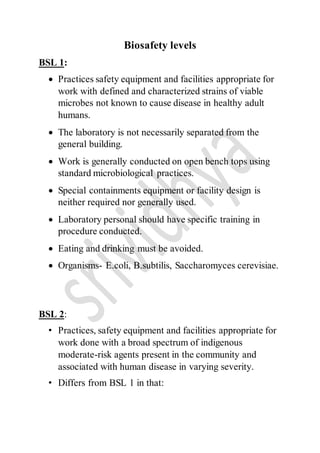
Biosafety levels and cabinets
- 1. Biosafety levels BSL 1: Practices safety equipment and facilities appropriate for work with defined and characterized strains of viable microbes not known to cause disease in healthy adult humans. The laboratory is not necessarily separated from the general building. Work is generally conducted on open bench tops using standard microbiological practices. Special containments equipment or facility design is neither required nor generally used. Laboratory personal should have specific training in procedure conducted. Eating and drinking must be avoided. Organisms- E.coli, B.subtilis, Saccharomyces cerevisiae. BSL 2: • Practices, safety equipment and facilities appropriate for work done with a broad spectrum of indigenous moderate-risk agents present in the community and associated with human disease in varying severity. • Differs from BSL 1 in that:
- 2. a) Laboratory personal have specific training in handling pathogenic agents and/or directed by competant scientist. b) Access to the lab is limited when work is being conducted. c) Extreme precautions are taken with contaminated sharp items. d) Certain procedures in which infectious aerosols maybe created are conducted in BSC. e) Class I & II BSC are used. f) Eg. HAV, HIV, HBV, HCV, pathogenic E.coli, staphylococcus aureus, salmonella, P. falciparum and Toxoplasma gondii. BSL 3: • Practices, safety equipment and facilities appropriate for work done with indigenous or exotic agents with a potential for respiratory transmission which may cause serious and potentially lethal infection. • More emphasis is placed on primary and secondary barriers to protect personal in the contagious area, the community, and the environment from exposure to potentially infecious aerosols. • A class I or class II BSC is required for work involving these agents. • Eg. M. tuberculosis, Francisella tularensis, Chlamydia psittaci, Venezuelan equine encephalitis virus, SARS corona virus, Coxiella burnetti, Ricketsia rickettsi.
- 3. BSL 4: • Practices, safety equipment and facilities appropriate for work done with dangerous and exotic agents which pose a high risk of life threatening disease. • Materials leaving the cabinet must be decontaminated and the cabinet must also be disinfected. • Workers must pass through a chemical shower. • Entry is strictly restricted. • The entrance is air locked. • Eg. Viruses that cause viral haemorrhagic fever, lassa virus, crimean-congo haemorrahagic fever. Pathogens like hendra virus, nipoh virus, flavi virus, variola virus.
- 4. Biosafety cabinets Biosafety cabinets are used as the primary means of containment for working safely with infectious microorganisms. Biosafety cabinets are designed to prevent biological exposure to personnel and the environment and may also protect experimental material from being contaminated when appropriate practices and procedures are followed. Biological safety cabinets use high efficiency particulate air (HEPA) filters in their exhaust and/or supply systems. These filtered cabinets are primarily designed to protect against exposure to particulates, including biological agents used in the cabinet. The Class I Biosafety Cabinet Provides personnel and environmental protection, but no product protection. It has a negative pressure ventilated cabinet. It has similar turbulent air flow as a chemical fume hood, but has a HEPA filter in the exhaust system to provide containment and environmental protection with front opening. This older class of biosafety cabinet is rarely seen in MUSC's biomedical and microbiological laboratories. Low and moderate risk agents can be handled using this type. All the air from the cabinet is exhausted through HEPA filter into the lab or outside
- 5. The Class II Biosafety Cabinet A1 type: It is designed with inward air flow to provide protection to the user, the experimental material and the environment. The Class II biological safety cabinet is the type most commonly used in MUSC's biomedical and microbiological laboratories. It provides product, environmental and personal protection. The air is mostly filtered. All the air from the cabinet is exhausted through HEPA filter into the lab or outside It has a positive pressured plenum No toxic chemical is handled in this type. 70% of the air is recirculated and 30% of the air is exhausted through HEPA filter. A2 type: It has both positive and negative pressured plenum. In case of the air leaking out of positive pressured plenum, it is trapped by negative pressured plenum. 70% of the air is recirculated and 30% of the air is exhausted through HEPA filter. Exhaust air is hard ducted. B1 type: 30% of the air is recirculated and 70% of the air is exhausted through HEPA filter. Products of BSL 2 and 3 are used in this type.
- 6. The cabinet exhaust system is connected to the building exhaust system and the air is ventilated out. B2 type: There is no recirculation in this type and so 100% of the air is exhausted. Radio nucleotides and toxic chemicals can be handled in this type. Exhaust hard ducted out. Products of BSL 2 and 3 are used in this type. The Class III Biosafety Cabinet The Class III biological safety cabinet is most suitable for work with biohazardous agents requiring high contain (biosafety level 3 or 4). The Class III cabinet is completely enclosed, HEPA filter-ventilated cabinet fitted with glove ports and decontamination capabilities for entry and exit of material. It offers the highest degree of personnel and environmental protection from infectious aerosols.